Oldsmobile Achieva 1998 Owner's Manuals
Manufacturer: OLDSMOBILE, Model Year: 1998, Model line: Achieva, Model: Oldsmobile Achieva 1998Pages: 356, PDF Size: 18.04 MB
Page 121 of 356
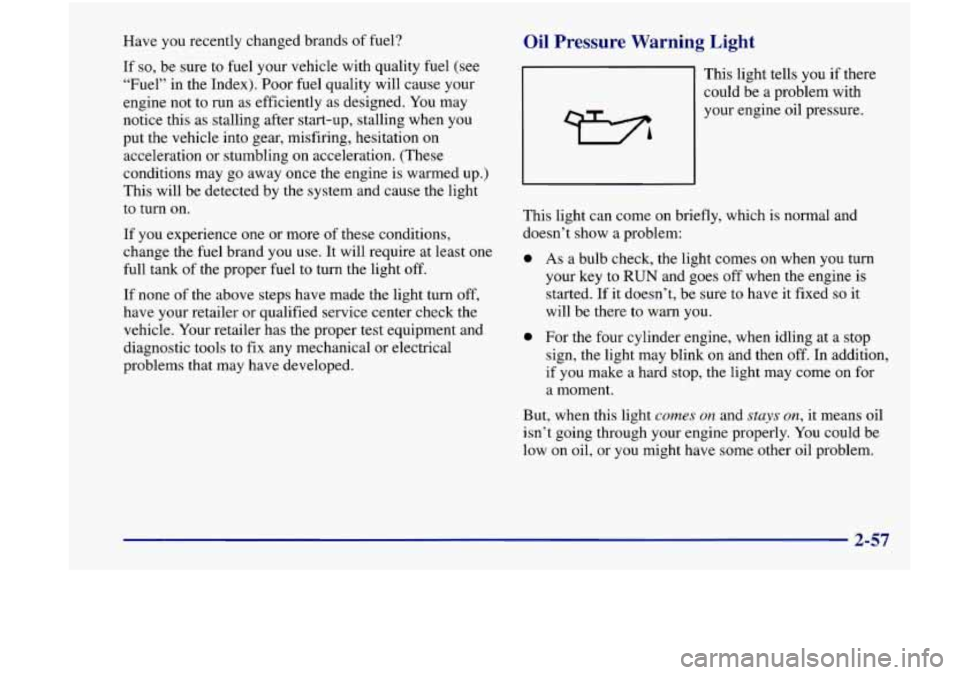
Have you recently changed brands of fuel?
If so, be sure to fuel your vehicle with quality fuel (see
“Fuel” in the Index). Poor fuel quality will cause your
engine not to run as efficiently as designed. You may
notice this as stalling after start-up, stalling when you
put the vehicle into gear, misfiring, hesitation on
acceleration or stumbling on acceleration. (These
conditions may go away once the engine
is warmed up.)
This will be detected by the system and cause the light
to turn
on.
If you experience one or more of these conditions,
change the fuel brand you use. It will require at least one
full tank of the proper fuel to turn the light off.
If none of the above steps have made the light turn off,
have your retailer or qualified service center check the
vehicle. Your retailer has the proper test equipment and
diagnostic tools to fix any mechanical or electrical
problems that may have developed.
Oil Pressure Warning Light
This light tells you if there
could be a problem with
your engine oil pressure.
This light can come on briefly, which is normal and
doesn’t show
a problem:
a
a
As a bulb check, the light comes on when you turn
your key to
RUN and goes off when the engine is
started. If it doesn’t, be sure to have it fixed
so it
will be there to warn you.
For the four cylinder engine, when idling at a stop
sign, the light may blink on and then off. In addition,
if
you make a hard stop, the light may come on for
a moment.
But, when this light
comes on and stays on, it means oil
isn’t going through your engine properly. You could be
low on oil, or you might have some other oil problem.
2-57
Page 122 of 356
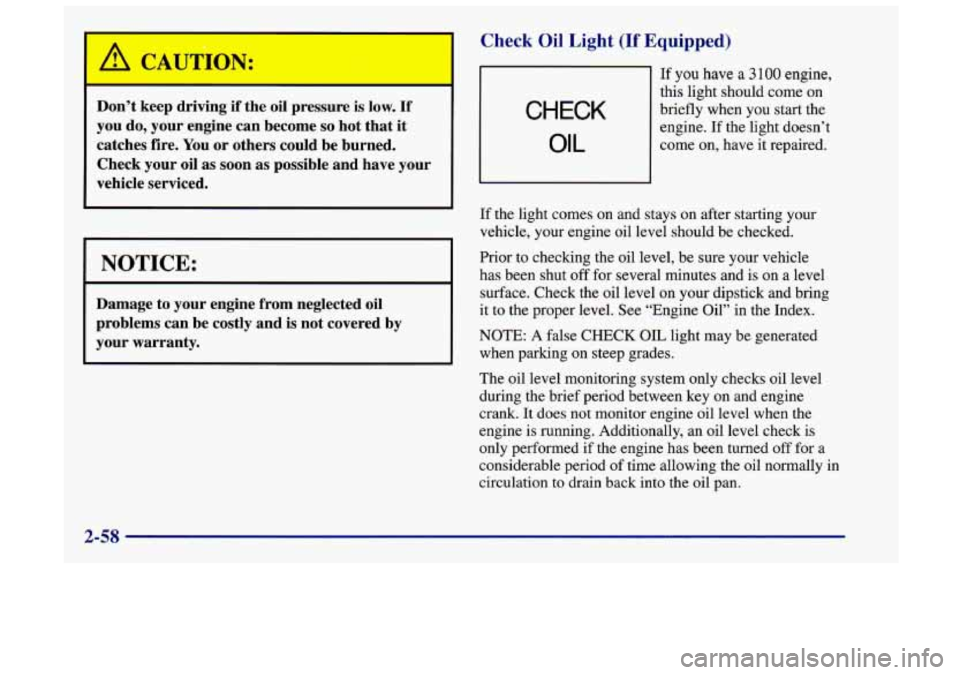
A CAUTION:
Don’t keep driving if the oil pressure is low. If
you do, your engine can become so hot that it
catches fire. You or others could be burned.
Check your oil as soon
as possible and have your
vehicle serviced.
Check Oil Light (If Equipped)
CHECK
OIL
If you have a 3 100 engine,
this light should come on
briefly when you start the
engine. If the light doesn’t
come on, have it repaired.
If the light comes on and stays on after starting your
vehicle, your engine oil level should be checked.
Prior to checking the oil level, be sure your vehicle
has been shut off for several minutes and is on a level
surface. Check the oil level on your dipstick and bring
Damage to your engine from neglected oil it to the proper level. See “Engine Oil” in the Index.
problems can be costly and is not covered by
your warranty.
NOTE: A false CHECK OIL light may be generated
when parking on steep grades.
The oil level monitoring system only checks oil level
during the brief period between key on and engine
crank.
It does not monitor engine oil level when the
engine is running. Additionally, an oil level check is
only performed if the engine has been turned off for a
considerable period of time allowing the oil normally in
circulation to drain back into the oil pan.
NOTICE:
2-58
Page 123 of 356
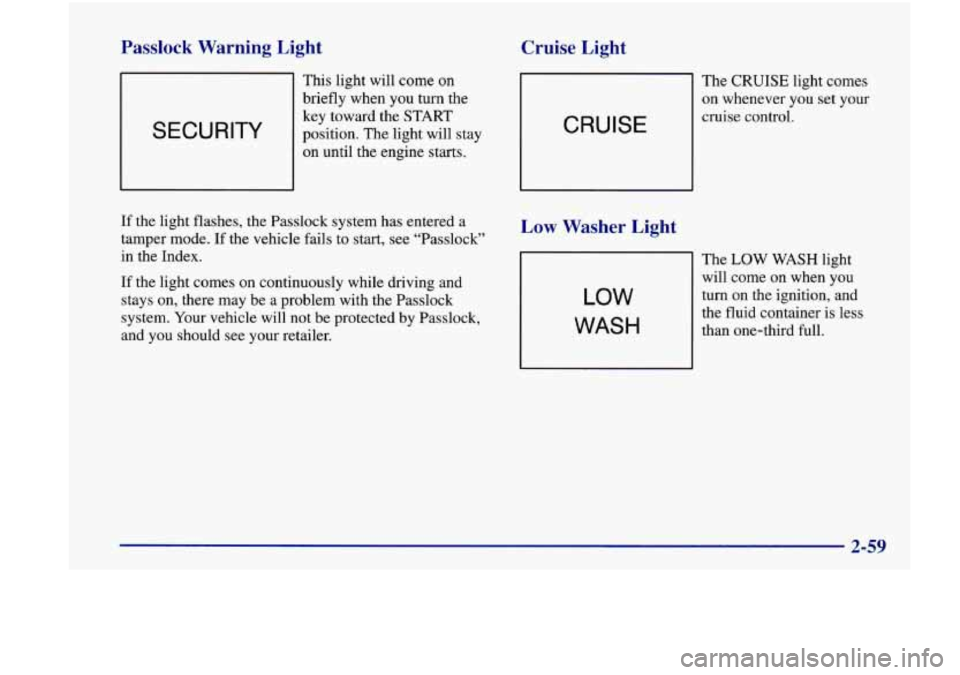
Passlock Warning Light
SECURITY
This light will come on
briefly when you turn the
key toward the
START
position. The light will stay
on until the engine starts.
Cruise Light
The CRUISE light comes
on whenever you set your
CRUISE
cruise control.
If the light flashes, the Passlock system has entered a
tamper mode. If the vehicle fails to start, see “Passlock”
in the Index.
If the light comes on continuously while driving and
stays on, there may be a problem with the Passlock
system. Your vehicle will not be protected by Passlock,
and you should see your retailer.
Low Washer Light
LOW
WASH
The LOW WASH light
will come on when you
turn on the ignition, and
the fluid container is less
than one-third full.
Page 124 of 356
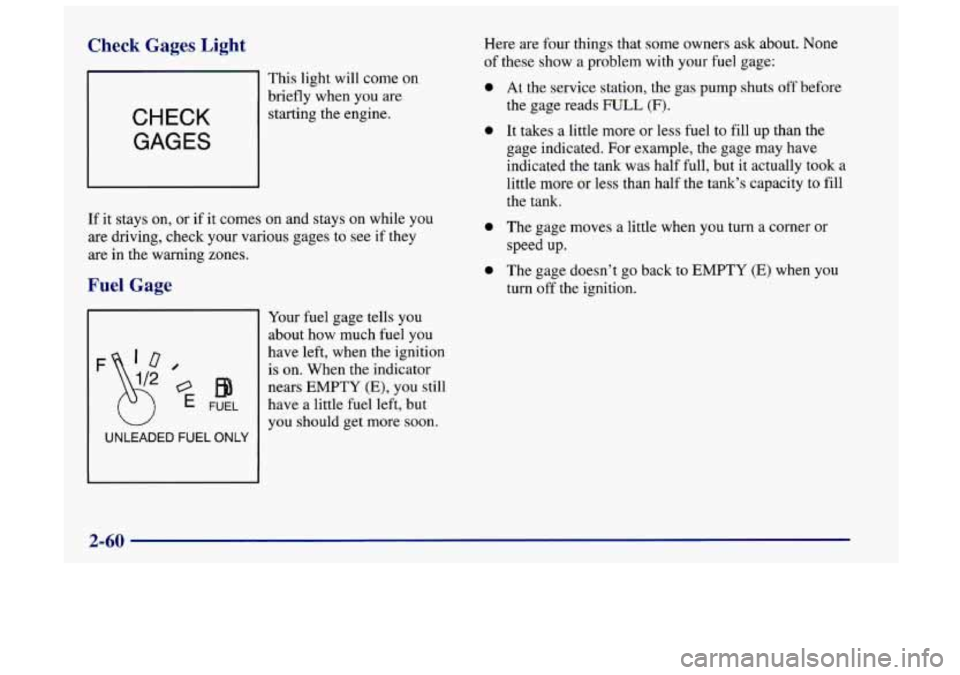
Check Gages Light
CHECK
GAGES
This light will come on
briefly when you are
starting the engine.
If it stays on, or if it comes on and stays on while you
are driving, check your various gages to see if they
are in the warning zones.
Fuel Gage
W
UNLEADED FUEL ONLY
Your fuel gage tells you
about how much fuel you
have left, when the ignition
is on. When the indicator
nears EMPTY
(E), you still
have a little fuel left, but
you should get more
soon.
Here are four things that some owners ask about. None
of these show a problem with your fuel gage:
0
0
0
0
At the service station, the gas pump shuts off before
the gage reads
FULL (F).
It takes a little more or less fuel to fill up than the
gage indicated. For example, the gage may have
indicated the tank was half full, but
it actually took a
little more or less than half the tank’s capacity to fill
the tank.
The gage moves a little when you turn a corner
or
speed up.
The gage doesn’t go back
to EMPTY (E) when you
turn
off the ignition.
2-60
Page 125 of 356
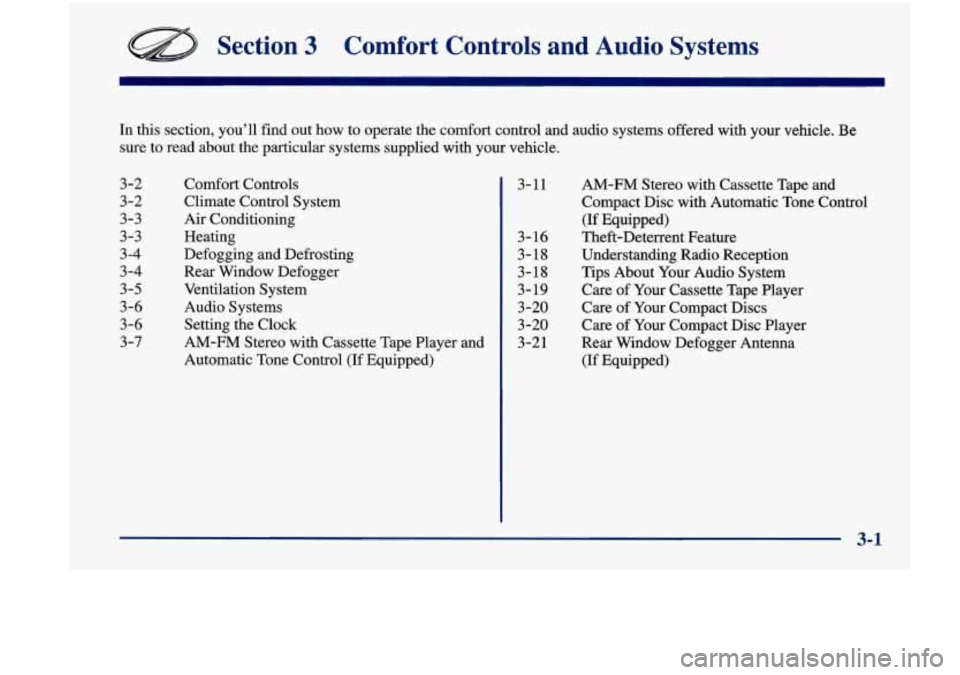
Section 3 Comfort Controls and Audio Systems
In this section, you’ll find out how to operate the comfort\
control and audio systems offered with your vehicle. Be
sure to read about the particular systems supplied with your vehicle.
3-2
3-2
3-3
3-3
3-4
3-4
3-5
3-6
3-6
3-7 Comfort Controls
Climate Control System
Air Conditioning Heating
Defogging and Defrosting
Rear Window Defogger
Ventilation System
Audio Systems
Setting the Clock
AM-FM Stereo with Cassette Tape Player and
Automatic Tone Control
(If Equipped)
3-16
3-18
3-18
3-19
3
-20
3 -20
3-2
1
3-11 AM-FM Stereo with Cassette Tape and
Compact Disc with Automatic Tone Control
(If Equipped)
Theft-Deterrent Feature
Understanding Radio Reception
Tips About Your Audio System
Care of Your Cassette Tape Player
Care of Your Compact Discs
Care of Your Compact Disc Player
Rear Window Defogger Antenna
(If Equipped)
3-1
Page 126 of 356
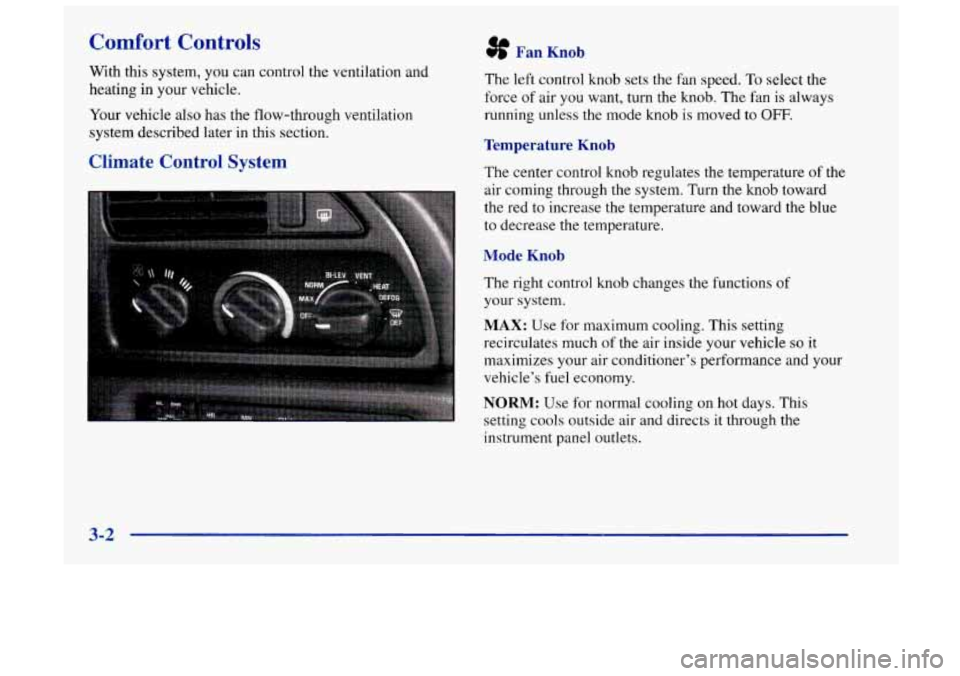
Comfort Controls
With this system, you can control the ventilation and
heating in your vehicle.
Your vehicle also has the flow-through ventilation
system described later in this section.
Climate Control System
sf Fan Knob
The left control knob sets the fan speed. To select the
force
of air you want, turn the knob. The fan is always
running unless the mode knob is moved to
OFF.
Temperature Knob
The center control knob regulates the temperature of the
air coming through the system.
Turn the knob toward
the red to increase the temperature and toward the blue
to decrease the temperature.
Mode Knob
The right control knob changes the functions of
your system.
MAX: Use for maximum cooling. This setting
recirculates much of the air inside your vehicle
so it
maximizes your air conditioner’s performance and your
vehicle’s fuel economy.
NORM: Use for normal cooling on hot days. This
setting cools outside air and directs it through the
instrument panel outlets.
3-2
Page 127 of 356
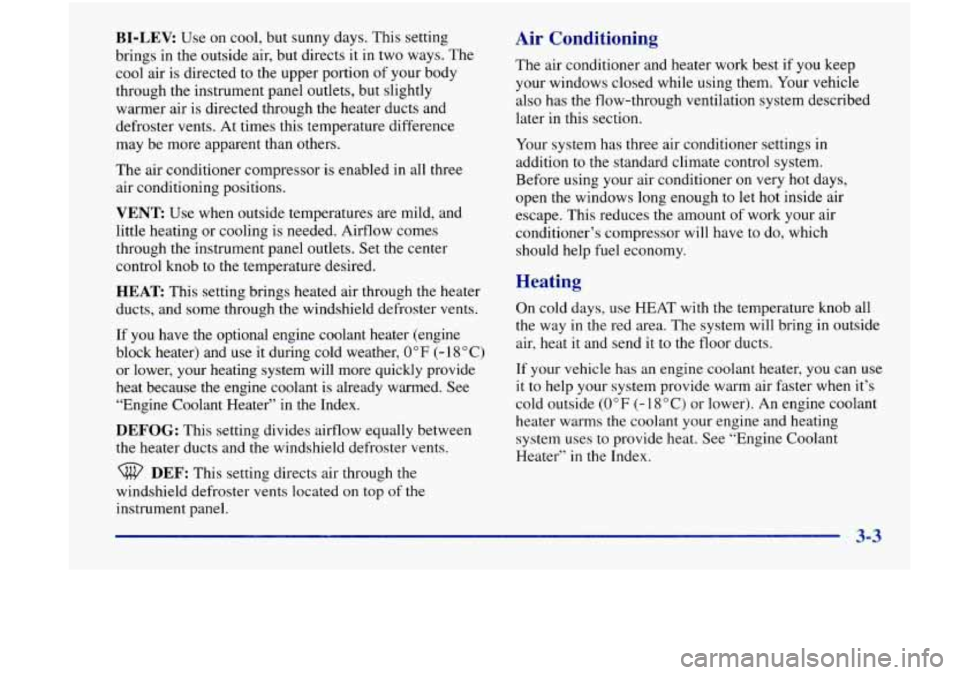
BI-LEV: Use on cool, but sunny days. This setting
brings in the outside air, but directs it in two ways. The
cool air is directed to the upper portion of your body
through the instrument panel outlets, but slightly
warmer air is directed through the heater ducts and
defroster vents. At times this temperature difference
may be more apparent than others.
The air conditioner compressor is enabled in all three
air conditioning positions.
VENT: Use when outside temperatures are mild, and
little heating or cooling is needed. Airflow comes
through the instrument panel outlets. Set the center
control knob to the temperature desired.
HEAT This setting brings heated air through the heater
ducts, and some through the windshield defroster vents.
If you have the optional engine coolant heater (engine
block heater) and use it during cold weather,
0 “F (- 18 O C)
or lower, your heating system will more quickly provide
heat because the engine coolant
is already warmed. See
“Engine Coolant Heater” in the Index.
DEFOG: This setting divides airflow equally between
the heater ducts and the windshield defroster vents.
DEF: This setting directs air through the
windshield defroster vents located
on top of the
instrument panel.
Air Conditioning
The air conditioner and heater work best if you keep
your windows closed while using them. Your vehicle
also has the flow-through ventilation system described
later
in this section.
Your system has three air conditioner settings in
addition to the standard climate control system.
Before using your air conditioner
on very hot days,
open the windows long enough to let hot inside air
escape. This reduces the amount of work your air
conditioner’s compressor will have to do, which
should help fuel economy.
Heating
On cold days, use HEAT with the temperature knob all
the way in the red area. The system will bring in outside
air, heat it and send it to the floor ducts.
If your vehicle has an engine coolant heater, you can use
it to help your system provide warm air faster when it’s
cold outside
(0°F (-18°C) or lower). An engine coolant
heater warms the coolant your engine and heating
system
uses to provide heat. See “Engine Coolant
Heater”
in the Index.
Page 128 of 356

Defogging and Defrosting
There are two settings for clearing your windows. For
each setting, adjust the temperature control as desired.
To rapidly defrost the windshield, rotate the temperature
knob to maximum heat and rotate the mode knob to the
defrost symbol. Rotate the fan to the highest speed.
Your vehicle is equipped with side window defogger
vents. The side window defogger vents are located on
each end of the instrument panel. For additional side
window defogging, rotate the mode knob to the
BI-LEV
position, rotate the fan knob to the highest speed and
aim the side vents on the instrument panel to the side
window. For increased aifflow to the side vents, close
the center vents.
Rear Window Defogger
The rear window defogger
uses a warming grid to
remove fog from the
rear window.
Press the defogger switch. The indicator light will glow.
If your vehicle is traveling under
45 mph (70 km/h), the
rear window defogger will turn off automatically after
about
10 minutes of use. If your vehicle is traveling over
45 mph (70 km/h), the defogger will operate
continuously. You can turn the defogger off by turning
off the ignition or pressing the switch again.
3-4
Page 129 of 356

Do not attach a temporary vehicle license across the
defogger grid on the rear window.
I NOTICE:
Don't use a razor blade or something else sharp
on the inside
of the rear window. If you do, you
could cut or damage the warming grid, and the
repairs wouldn't be covered by your warranty.
Ventilation System
Your Oldsmobile's flow-through ventilation system
supplies outside air into the vehicle when it
is moving.
Outside air will also enter the vehicle when the fan
is running.
Air Outlets
Adjust the direction of airflow by moving the louvered
vents with the center control
knob.
3-5
Page 130 of 356
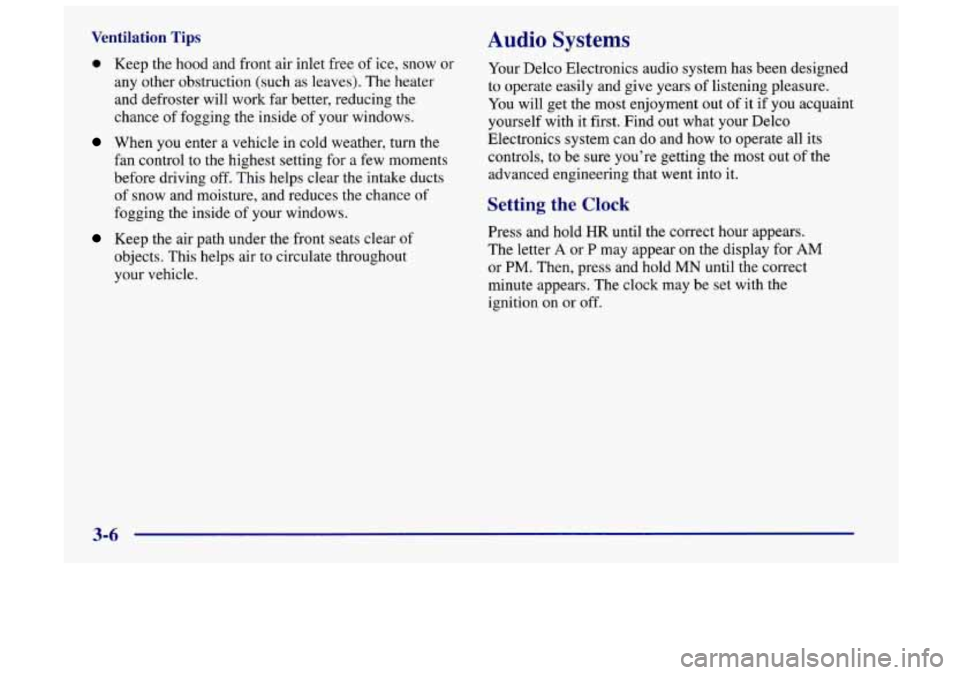
Ventilation Tips Audio Systems
0 Keep the hood and front air inlet free of ice, snow or
any other obstruction (such as leaves). The heater
and defroster will work far better, reducing the
chance of fogging the inside of your windows.
When you enter a vehicle in cold weather, turn the
fan control to the highest setting for a few moments
before driving off. This helps clear the intake ducts
of snow and moisture, and reduces the chance
of
fogging the inside of your windows.
Keep the air path under the front seats clear of
objects. This helps air to circulate throughout
your vehicle. Your
Delco Electronics audio system has been designed
to operate easily and give years
of listening pleasure.
You will get the most enjoyment out
of it if you acquaint
yourself with it first. Find out what your Delco
Electronics system can do and how to operate all its
controls, to be sure you’re getting the most out of the
advanced engineering that went into it.
Setting the Clock
Press and hold HR until the correct hour appears.
The letter
A or P may appear on the display for AM
or PM. Then, press and hold MN until the correct
minute appears. The clock may be set with the
ignition on
or off.
3-6